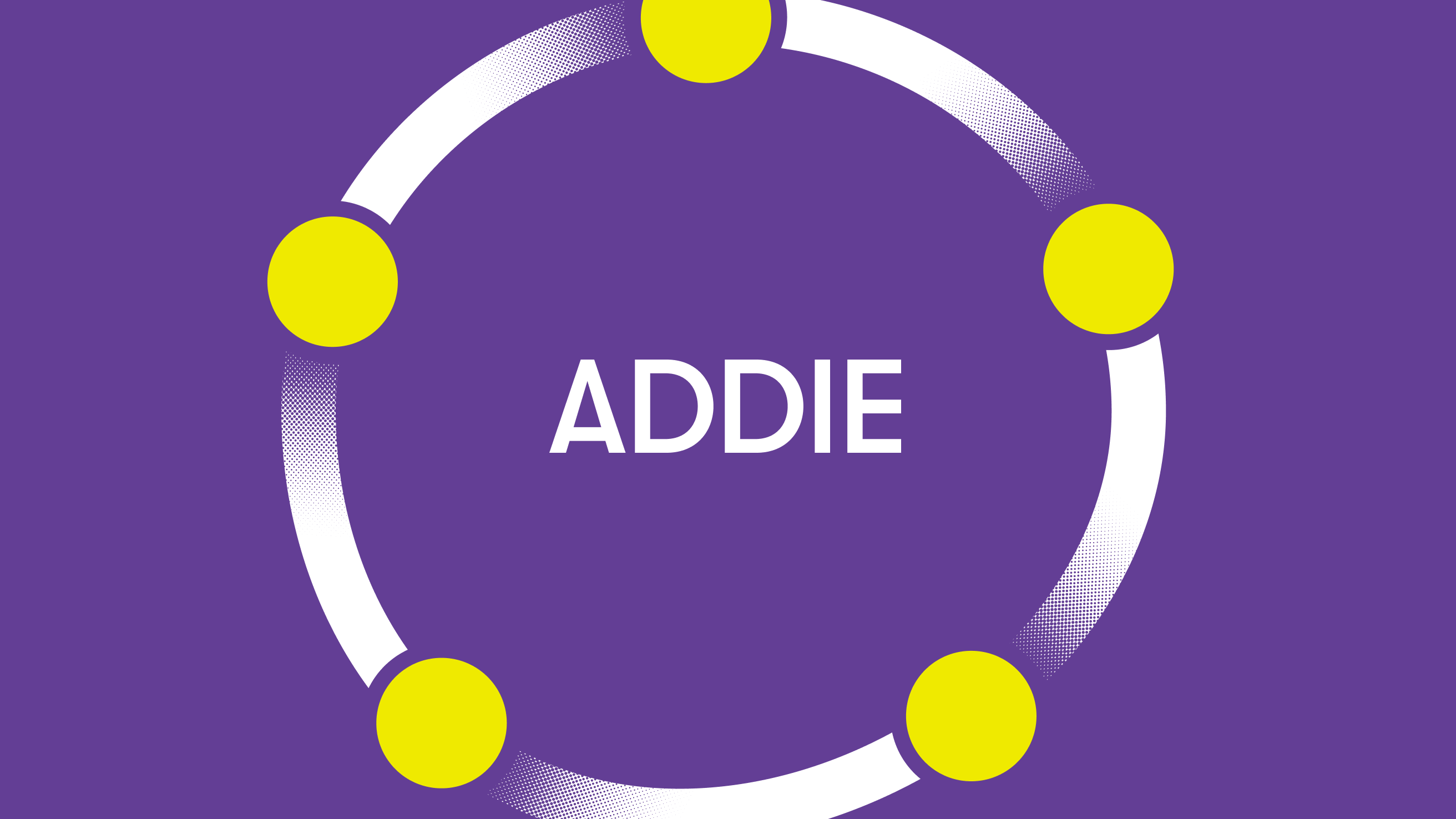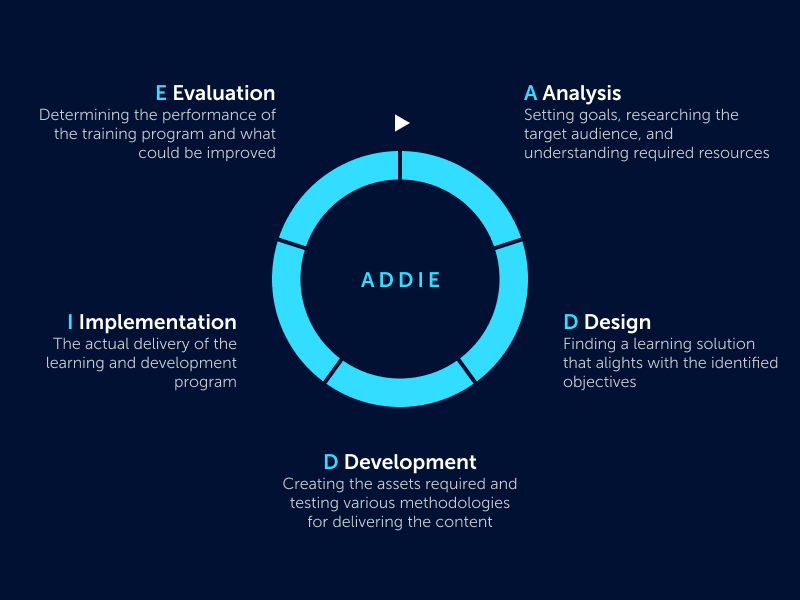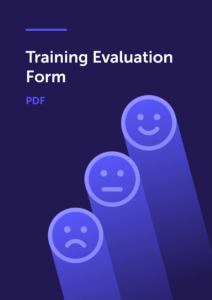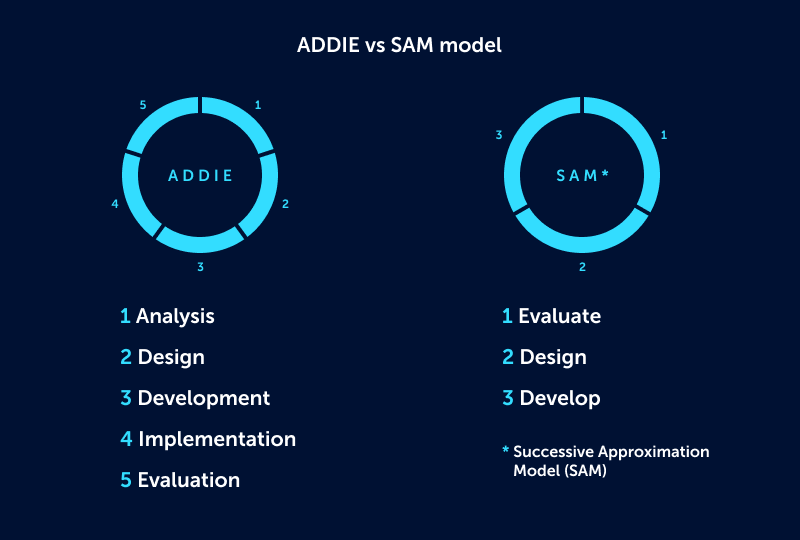ADDIE model
The ADDIE model is a well-known and widely adopted instructional design tool for increasing the success of new training programs.

Organizations need to continually develop their employees with additive training programs. Technology and customer expectations are constantly evolving. Therefore, to compete in today’s marketplace, you require a talented and up-to-date workforce.
This places a significant burden on instructional design and producing learning and development courses with tangible results. The ADDIE model is a well-known and widely adopted tool that can increase the success of new training programs.
In this blog, we will take you through:
- What is ADDIE training model?
- Why ADDIE model?
- A brief history of the ADDIE model
- The five steps of the ADDIE model
- ADDIE model example – Corporate training
- Advantages and disadvantages of ADDIE
- ADDIE vs. SAM – Which model best suits your learning and development project?
What is the ADDIE training model?
ADDIE is a popular model for instructional design, providing a framework to produce effective learning and development programs. “ADDIE” itself is an acronym for the five stages of the model:
- Analyze
- Design
- Development
- Implementation
- Evaluation
These five clearly defined processes help ensure training programs and their resources have the required elements to succeed.
In addition, they give instructional designers a structure to rely on and consider as they progress through the development of new learning and development projects.

Why ADDIE model?
Research shows that ADDIE methodologies offer a systems-based, iterative learning and development design strategy while incorporating feedback and review to improve.
When designing a new training program, it can be easy to get lost in the details.
The ADDIE model provides a sequential list of requirements with known inputs and outputs such that staff developing the course can maintain a big-picture view of what they are trying to achieve.
Many organizations already implement aspects of the ADDIE model without it becoming a formalized design structure. However, due to the fast-paced nature of business, it is common for teams to focus on the design, development, and implementation stages.
Unfortunately, this approach often fails to capture the original need of the program and the impact it has on employees. While perhaps requiring additional time and examination, ADDIE goes further to understand the goals and outcomes of new learning and development courses.
The ADDIE model is generic and applicable to any type of learning experience, audience, or industry. The fact that it is not industry-specific has helped ADDIE become one of the most common design models in use. Several other models for instructional design are based on variations of the ADDIE model.
A brief history of the ADDIE model
The Centre for Education Technology at Florida State University first introduced the ADDIE model in 1975 for the US army. Its use later spread across all other branches of the US armed forces.
ADDIE is based on a previous instructional design model from the US Air Force known as the “Five-Step Approach.” While the ADDIE model holds on to the five steps, it breaks down each of its broad processes into many more substages for greater detail.
ADDIE has evolved over the years, with revisions to the five stages, making the model more dynamic and interactive. However, a version of ADDIE similar to what we know today has been in use since the middle of the 1980s.
The 5 steps of the ADDIE model
Step 1. Analyze

The first step of the ADDIE model is setting goals for the new program and researching the intended target audience. This includes the audience’s existing knowledge and skills, future training needs, and the appropriate training environment and methods that organizations could deploy.
Learning and development courses must have a clear goal matching the audience’s skills and intelligence to succeed.
By taking the time to analyze the course’s recipients, you can ensure pre-existing knowledge is not being re-delivered and that the course outcome matches the business’s real-life needs.
The analysis step of the ADDIE model typically requires researching the organization’s existing learning and development material, identifying potential problems or knowledge gaps, and reviewing previous programs to see what was successful in the past. This means effective communication with both management and their employees (potentially through surveys or focus groups) to understand the existing situation.
A simple way of identifying areas of improvement is gap analysis – comparing the desired situation to your current situation. This could be related to sales and financial performance, becoming more efficient and embracing new technologies (digital transformation), improving company culture through new diversity initiatives, or something completely different.
To manage, plan, and monitor existing and desired skills for a role, team, department, project, or an entire company you can use the Skill matrix framework.
Suppose the root cause of the problem is employees lacking specific knowledge, skills, or the right mindset. Organizations could make tangible improvements with new learning and development programs in that case. Skill Matrix template is a good start to identify missing competencies and find potential skill gaps in your organization.

Skills matrix template
Efficiently assess, manage, and maximize your team’s potential and streamline your workflow.
Download templateTraining needs analysis is another critical tool that can help organizations determine the information to deliver in the new program and define the goals that will feed into every future step of the ADDIE model.
Other essential tasks an organization needs to consider during step 1 of the ADDIE model include:
- Identifying all involved stakeholders
- Understanding the future resources required for the program
- Gathering detailed information on specific audience personas for future training design
The analysis step is one often overlooked during instructional design. However, taking the time to set the foundations for your new training program gives you the base needed for the steps to come.
You should always clearly understand the problem before designing the solution.
Detailed analysis saves time and money later in the process by improving the training program’s impact.
Step 2. Design

This is where all the information gathered during the analysis step is dissected to make informed decisions about the design of the development program.
The design step requires a systematic approach to the specific learning objectives identified, the course’s subject matter and content outlines, and how it will be delivered in terms of content, exercises, media, etc.
With a systematic strategy, you can logically assess the possible scenarios in an orderly fashion to understand the best approach that achieves desired learning outcomes.
Organizations should create a high-level outline of the entire program to structure the learning interventions and specify objectives for each aspect participants receive.
It is also vital to determine how participants will be evaluated. While not every training program requires individual assessments, you should have a strategy in place to measure its impact and track its value.
Finally, before developing the program’s specifics, the design stage should conclude with buy-in from all stakeholders. This means briefings on learning objectives, their impact, and the decisions that went into the course’s outline.
This is the last step where significant changes to the program as a whole can be made, so it is imperative that stakeholders are happy with the chosen goals and processes needed to achieve them.
Step 3. Development

The development stage takes the outline defined in step 2, creates the assets required to bring it to life, and tests various methodologies for delivering the content.
While the previous two steps involve examination, planning, and generating ideas, development is when these ideas are first put into action.
It is called “development” for a reason, though, and the outcomes of this step will evolve during the process. Therefore, you should be prepared to try multiple approaches to determine the content and delivery that best fits the target audience. Also, always double-check the content’s accuracy and look at the course as a whole to ensure it flows naturally.
With the design program outline for guidance, you need to create all the required assets. This could be presentations, videos, graphics, instruction manuals, assessments, or anything else you’ll need.
Remember, there isn’t a “correct” way of getting this done, and you should consider the best option for your situation. For example, do you have the facilities to produce everything in-house, are you going to outsource the production to third parties, or a mix of both?
Step 4. Implementation

Step 4 is the actual delivery of the learning and development program.
A significant part of implementing the course is project management and getting into the details of everything the program requires, from communication, logistics, and data collection to identifying and training staff who can deliver the content in an engaging way.
Good project managers can adapt on the go to ensure they deliver the best possible product to the course participants. This could mean tweaking content for a change in audience persona or the minutiae of having everything ready to go on the day.
The training of course leaders needs to cover:
- The curriculum
- The required outcomes
- How it should be delivered
- The use of course assets and resources
- Any assessment/feedback procedures
However you choose to assess the impact of the training program, the implementation phase is your chance to gather as much data as possible for evaluation.
Step 5. Evaluation

Evaluation, the final stage of the ADDIE model, is when you determine the performance of the training program. You want to go into detail on every aspect of the project:
- What did the participants learn?
- Can they apply these skills in their daily work?
- Were participants engaged and motivated to learn?
- Did the program meet its goals?
The primary objectives of the evaluation step are to determine if the initial goals set way back in step 1 were met and what could be improved.
The findings from this step feed back into the next project’s analysis stage, allowing you to refine training practices and enhance your success rate and efficiency moving forward.
Evaluation can be separated into two parts: formative and summative. Formative evaluation happens during every step of the ADDIE model to keep the program on track. Summative evaluations refer to specific testing assessed at the end to evaluate what participants learned and the program’s effectiveness. Staff running the course should send the evaluation results to all relevant stakeholders.
An important consideration at the end of a new learning and development program is assessing the business case for future work. Does the program generate enough value to warrant further funding?
Furthermore, L&D professionals increasingly use learning analytics and automation to identify the weak points of learning, patterns and potential of employees.

Training evaluation form
Get a handy printable form for evaluating training and course experiences.
Download nowADDIE model example – Corporate Training
The ADDIE model is a general-purpose approach to instructional design. However, to get the ideas and methodology across, it can help to be more specific and look at an example.
Below is a demonstration of the specific outcomes from the five ADDIE steps in the case of corporate training – the process of training employees via various techniques or activities.
Analyze
- Gap analysis
- Problem identification
- Catalog of existing material related to the subject matter
- An understanding of the target audience and their pre-existing knowledge/skillsets
- List of all relevant stakeholders
- Resources that needed for the program
- The big picture goals of the learning and development program
Design
- Defined learning objectives
- High-level course outline
- Delivery method (interface and environment)
- Course progression
- Timeframe for each activity
- Tools required to create course assets
- Assessment/feedback strategy
- Alignment with relevant stakeholders
Development
- Creation of necessary course assets
- Test and evaluate different assets and delivery approaches
- Finalize and quality check course details
Implementation
- Train staff to deliver the program
- Project management (logistics, scheduling, communication, resources, etc.)
- Track the program and its performance in real-time
- Data collection
Evaluation
- Analyze collected data
- Assess the program’s performance (content delivered, behavioral changes, etc.)
- Identify future changes to improve success/efficiency
Advantages and disadvantages of ADDIE
Advantages
- Structure – ADDIE provides a structured framework to guide learning and development staff through the process of instructional design.
- Provides a starting point – Often, finding a starting point is the hardest part of a project. With ADDIE, the steps and their outcomes are laid out for you.
- Goal-centric view – The ADDIE model begins with detailed research to define the program’s overall goals. This ensures objectives remain front and center throughout the following steps.
- Industry/audience/goal agnostic – ADDIE is a versatile model applicable to any industry or audience and not dependent on a specific goal.
- Self-improving – With detailed evaluation feeding into future analysis, the ADDIE model ensures learning and development programs improve over time.
Disadvantages
- Time-consuming and costly – The level of detail required before implementing the program means the ADDIE model can be a time-consuming and expensive process.
- Linear and inflexible – With a rigid linear structure, it can be hard to adapt to changes and react to new information.
- Audience accuracy – Unlike other more iterative models that quickly implement and discover learner needs during the project, the ADDIE model puts understanding the target audience at the start of the process. This can lead to difficulties trying to accurately discover the pre-existing knowledge base and the right level at which to pitch the course’s content.
ADDIE vs. SAM – Which model best suits you?
While ADDIE is a popular approach to developing learning and development projects, it is one of many models available.
SAM, stands for Successive Approximation Model, is another popular instructional design model seen as an alternative to ADDIE. The SAM has multiple variations, but they all try to introduce iteration into the design process. This includes rapid prototyping and adding development and implementation earlier in the process.

SAM attempts to counter one of the main drawbacks of the ADDIE model, the time-consuming nature of getting the program created and implemented. Instead, SAM is a rapid development model, quickly producing new training programs with periodic reviews and evaluations to iterate the process and improve course outcomes.
Comparison ADDIE and SAM models
| ADDIE | SAM | |
|---|---|---|
| First Introduced | Developed by the Florida State University in 1975 | Introduced by Allen Interactions in 2012 |
| Timescale | Slow | Fast |
| Process | Linear | Cyclical |
| Errors | Identified late in the process | Identified earlier in the process |
| Feedback | Feedback occurs late in the process | Faster feedback from participants and clients |
| Flexibility | Rigid | Relatively flexible |
| Research | Considerable research goes into the design/development of the program | Little research performed; instead, information learned during rapid implementations |
| Success rate | Higher chance of success first time | Likely requires rework and program iteration |
| Cost | More expensive | Less expensive |
ADDIE is a slower pace more systematic approach to instructional design compared to SAM which enables a faster path to implementation. However, early SAM programs are less polished and generally require multiple iterations and rework to achieve the best results.
The choice between the two doesn’t have to be mutually exclusive. Depending on the situation and project’s time pressures, it is helpful for organizations to have an understanding of both models. This allows them to pick the optimal approach for each given program.
The choice often comes down to the team putting together the learning and development course and how they like to work. Some prefer taking the time to fully understand the problem, then utilizing ADDIE’s more comprehensive framework to deliver a great product. Others enjoy learning by doing and seeing what fast prototype courses look like in practice before refining based on feedback.

Training evaluation form
Get a handy printable form for evaluating training and course experiences.
Download now



